One of our highlights of last year took place in November 2023, when the Mindset team had the privilege of presenting at the SAP AppHaus 10-year anniversary event in Heidelberg, Germany. This exclusive gathering of the global SAP AppHaus Network marked a decade of customer co-innovation and collaboration in the realm of human-centered design with SAP technologies. Members from Bengaluru, Minneapolis, and New York represented the Mindset team, each bringing their unique insights and expertise. Our focus was on a cutting-edge topic: using a human-centered approach to innovation for GenAI, powered by SAP Business Technology Platform.
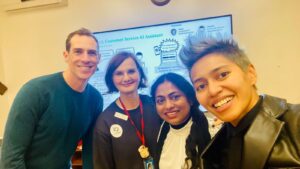
This blog post delves into the content of our presentation, showcasing our approach to tackling one of today’s most pressing business challenges.
Motivation: The Challenge of Customer Service in Call Centers
Our use case solution was inspired by one of our customers’ call center challenges, which was a few years before GenAI was widely accessible. The modern call center faces a daunting challenge: managing an overwhelming volume of calls efficiently while maintaining high customer satisfaction. We spotlighted a case study motivated by one of our clients, where Customer Service Representatives (CSRs) grappled with long average handling times of 17 minutes and 34 seconds, compounded by call volumes 11% above the expected level. This situation not only strained customer relations but also placed undue pressure on staff, escalating the cost per contact.
The Design Challenge and Mindset’s Approach
Faced with this challenge, we posed a critical question: “How might we provide Customer Service Reps access to SAP data in a timely fashion to answer customer calls more effectively and efficiently?” Our approach was rooted in Human-Centered Design, blending elements of design thinking and architecture thinking. This approach prioritized the needs and experiences of end-users, ensuring that our solutions were not only technologically advanced but also intuitively aligned with user requirements.
Using SAP Human-Centered Approach to Innovation
Our solution unfolded in a systematic, phased manner, informed by SAP AppHaus tried and true methodology that blends Design Thinking and Architecture Thinking (see illustration below).
- Phase 1 – Explore: we clarified the scope and identified key business metrics.
- Phase 2 – Discover: involved thorough end-user research and establishing a baseline architecture.
- Phase 3 – Design: we developed prototypes ranging from low to high fidelity and defined solution components. This phase integrated SAP BTP, SAP S/4HANA Private Cloud, and Microsoft Azure, amongst others.
- Phase 4 – Deliver: building of the solution application and the measurement of its impact and business value.
- Phase 5 – Run & Scale: while we have yet to embark on this phase, we envision our focus to be on optimization through feedback and continuous KPI tracking.
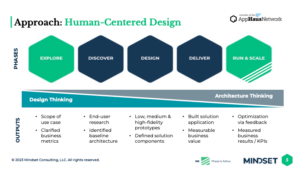
Design Thinking: Storyboard and Personas
An integral part of our presentation was a storyboard (illustrated below) featuring two personas: Maya, a customer and businesswoman, and Charlie, a CSR. This storytelling approach utilizes SAP AppHaus innovation toolkit called Scenes, which helped us convey the practical applications of our solution in a relatable and engaging way. Maya and Charlie’s experiences illustrated the real-world challenges and benefits of our innovative solution, making the technology accessible and understandable to our audience.
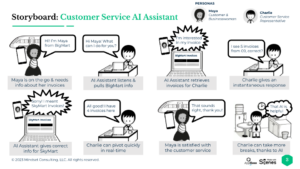
Enterprise Architecture Thinking: Solution Concept Diagram
The products and technologies for our Customer Service AI Assistant included the following:
- SAP BTP Work Zone hosted application
- AI integrations, specifically Large Language Model (LLM) integration, i.e. ChatGPT
- SAP BTP Business Application Studio
The illustration below shows how SAP BTP is linked with OpenAI via Azure Reference Architecture. For more information on the technical details and solution architecture, check out our colleague Ethan Jewett’s video on this use case.
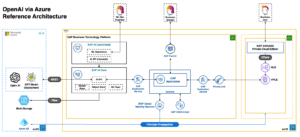
The Demo – Customer Service AI Assistant
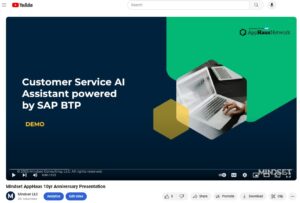
Our demo showcased the Customer Service AI Assistant in action. This tool enables real-time visibility of customers’ contextual information and centralizes access to their data, eliminating the need to navigate through multiple SAP systems. Notably, it allows customer inquiries to be answered in seconds rather than minutes.
Implications, Outcomes, and Considerations
The integration of an LLM model (like ChatGPT) with SAP customer, sales, delivery, and invoice data was a game-changer. This enabled the provision of contextual answers in real time during customer calls. We projected that the Average Handling Time (AHT) could be reduced by up to 50%, as there was no longer a need to navigate multiple SAP systems for common customer questions. This AI augmentation promised increased efficiency, enhanced customer satisfaction, and reduced costs, thereby boosting ROI.
There are, however, some considerations with the Customer Service AI Assistant:
- CSRs typically have their own way of doing things, such as how their screen is laid out with various applications, including the respective call center software, note-taking application, timer, etc. As such, the User Interface (UI) of the Customer Service AI Assistant application would need to complement and not obstructing the other applications a CSR would need access to. We can achieve this by co-creating the experience with the CSR to ensure a delightful experience.
- CSRs would need to have more agency with the context provided by the Customer Service AI Assistant application. This is especially important when the information provided is not accurate, which would require human intervention in order to access the correct information as the CSR is conversing with a customer.
- There is such a thing as being too efficient – CSRs take pride in their job when it comes to making small talk as they are multitasking during their call with a customer. As such, it is important to note that while time savings and efficiency gains are crucial, it is equally important to emphasize in CSR training the importance of maintaining such conversations during customer interactions to ensure a human-centered experience for both the customer and the CSR.
- As with most emerging technologies, the GenAI has yet to mature in terms of recognizing various accents by default. You may notice from the demo video how English is a second language for myself and Paru (see ‘Behind the Scenes’ below), which impacts the accuracy of the augmented information. Such situations can be mitigated by Advanced Speech Recognition (ASR) systems such as Whisper, which we believe will get better with more hours of data training.
Conclusion and Audience Engagement
Our presentation concluded with a recap of these transformative insights and their implications. We then opened the floor for discussion, inviting valuable feedback and engaging in a thought-provoking dialogue with the audience. The sentiments ranged from finding the use case to be purposeful for call centers, to finding the storyboard (Scenes) as an effective communication tool with developers, to inquiring about ASRs (as mentioned in our consideration in point #4 above). All in all, this exchange underscored the significance of our findings and the excitement surrounding the future of AI in customer service.
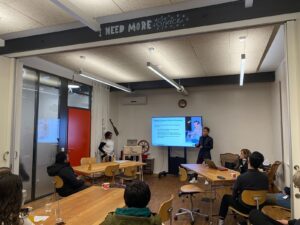
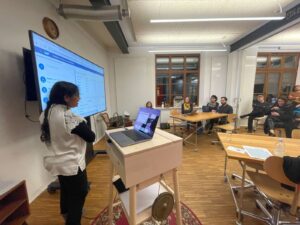
Final Thoughts
As we reflect on the event, it’s clear that the convergence of human-centered design and advanced technology like GenAI holds immense potential for transforming customer service. By placing the user at the heart of innovation and leveraging the capabilities of the SAP Business Technology Platform, we are not just solving today’s challenges but also paving the way for a more efficient, customer-centric future. Our call to action: connect with us to unpack your business needs and determine the right fit for GenAI in creating impact for your customers, employees and your business as a whole.